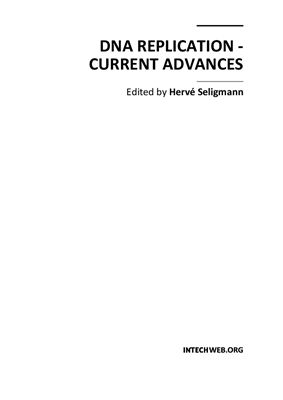InTech. 2011. 708 p.v
The study of DNA advanced human knowledge in a way comparable to the major theories in physics, surpassed only by discoveries such as fire or the number zero. However, it also created conceptual shortcuts, beliefs and misunderstandings that obscure the natural phenomena, hindering its better understanding. The deep conviction that no human knowledge is perfect, but only perfectible, should function as a fair safeguard against scientific dogmatism and enable open discussion. With this aim, this book will offer to its readers 30 chapters on current trends in the field of DNA replication. As several contributions in this book show, the study of DNA will continue for a while to be a leading front of scientific activities.
Contents
DNA Structure
DNA Structure: Alphabet Soup for the Cellular Soul
Replication Demands an Amendment of the Double Helix
Phosphorothioation: An Unusual Post-Replicative Modification on the DNA Backbone
Mitosis and DNA Replication and Life Origination Hydrate Hypotheses: Common Physical and Chemical Grounds
Mutations
Strand-specific Composition Bias in Bacterial Genomes
Mutation Pattes Due to Converging Mitochondrial Replication and Transcription Increase Lifespan, and Cause Growth Rate-Longevity Tradeoffs
Mitochondrial DNA Replication in Health and Disease
Damage and Replication Stress Responses
Replication Origins, Forks, Chromatine Organization
Relationship between Fork Progression and Initiation of Chromosome Replication in E. coli
Replication Origin Selection and Pre-Replication Complex Assembly
The Coordination between DNA Replication Initiation and Other Cell Cycle Events
The Organisation of Replisomes
Eukaryotic Replication Barriers: How, Why and Where Forks Stall
Control of Telomeric DNA Replication: Genetics, Molecular Biology, and Physiology
Telomere Maintenance in Organisms without Telomerase
Eukaryote DNA Replication and Recombination: an Intimate Association
The Cell Cycle and Replication
Cell Cycle Regulation of DNA Replication in S. cerevisiae
Free Histones and the Cell Cycle
Involvement of Linker Histones in the Regulation of Replication Timing
Replication Timing: Evolution, Nuclear Organization and Relevance for Human Disease
The Silencing Face of DNA Replication: Gene Repression Mediated by DNA Replication Factors
Proteins in Replication
Faithful DNA Replication Requires Regulation of CDK Activity by Checkpoint Kinases
Regulation of the G1/S Transition in Adult Liver: Expression and Activation of the Cyclin Dependent Kinase Cdk1 in Differentiated Hepatocytes is Controlled by Extracellular Signals and is Crucial for Commitment to DNA Replication
Binding of Human MCM-BP with MCM2-7 Proteins
DNA Replication in Animal Systems Lacking Thioredoxin Reductase I
Replication and Diseases
Prevalence of Reactivation of Hepatitis B Virus DNA Replication in Rheumatoid Arthritis Patients
Oncogenic Aspects of HPV Infections of the Female Genital Tract
The Role of E2 Proteins in Topoisomerase I and II Expression in Recurrent Colorectal Cancer Cells: A Dubious MatterPapillomavirus DNA Replication
Bacterial Genetics of Large Mammalian DNA Viruses: Bacterial Artificial Chromosomes as a Prerequisite for Efficiently Studying Viral DNA Replication and Functions
The study of DNA advanced human knowledge in a way comparable to the major theories in physics, surpassed only by discoveries such as fire or the number zero. However, it also created conceptual shortcuts, beliefs and misunderstandings that obscure the natural phenomena, hindering its better understanding. The deep conviction that no human knowledge is perfect, but only perfectible, should function as a fair safeguard against scientific dogmatism and enable open discussion. With this aim, this book will offer to its readers 30 chapters on current trends in the field of DNA replication. As several contributions in this book show, the study of DNA will continue for a while to be a leading front of scientific activities.
Contents
DNA Structure
DNA Structure: Alphabet Soup for the Cellular Soul
Replication Demands an Amendment of the Double Helix
Phosphorothioation: An Unusual Post-Replicative Modification on the DNA Backbone
Mitosis and DNA Replication and Life Origination Hydrate Hypotheses: Common Physical and Chemical Grounds
Mutations
Strand-specific Composition Bias in Bacterial Genomes
Mutation Pattes Due to Converging Mitochondrial Replication and Transcription Increase Lifespan, and Cause Growth Rate-Longevity Tradeoffs
Mitochondrial DNA Replication in Health and Disease
Damage and Replication Stress Responses
Replication Origins, Forks, Chromatine Organization
Relationship between Fork Progression and Initiation of Chromosome Replication in E. coli
Replication Origin Selection and Pre-Replication Complex Assembly
The Coordination between DNA Replication Initiation and Other Cell Cycle Events
The Organisation of Replisomes
Eukaryotic Replication Barriers: How, Why and Where Forks Stall
Control of Telomeric DNA Replication: Genetics, Molecular Biology, and Physiology
Telomere Maintenance in Organisms without Telomerase
Eukaryote DNA Replication and Recombination: an Intimate Association
The Cell Cycle and Replication
Cell Cycle Regulation of DNA Replication in S. cerevisiae
Free Histones and the Cell Cycle
Involvement of Linker Histones in the Regulation of Replication Timing
Replication Timing: Evolution, Nuclear Organization and Relevance for Human Disease
The Silencing Face of DNA Replication: Gene Repression Mediated by DNA Replication Factors
Proteins in Replication
Faithful DNA Replication Requires Regulation of CDK Activity by Checkpoint Kinases
Regulation of the G1/S Transition in Adult Liver: Expression and Activation of the Cyclin Dependent Kinase Cdk1 in Differentiated Hepatocytes is Controlled by Extracellular Signals and is Crucial for Commitment to DNA Replication
Binding of Human MCM-BP with MCM2-7 Proteins
DNA Replication in Animal Systems Lacking Thioredoxin Reductase I
Replication and Diseases
Prevalence of Reactivation of Hepatitis B Virus DNA Replication in Rheumatoid Arthritis Patients
Oncogenic Aspects of HPV Infections of the Female Genital Tract
The Role of E2 Proteins in Topoisomerase I and II Expression in Recurrent Colorectal Cancer Cells: A Dubious MatterPapillomavirus DNA Replication
Bacterial Genetics of Large Mammalian DNA Viruses: Bacterial Artificial Chromosomes as a Prerequisite for Efficiently Studying Viral DNA Replication and Functions

